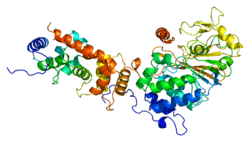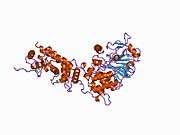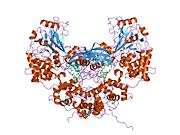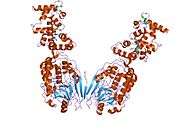Calcineurin
Calcineurin (CaN) is a calcium and calmodulin dependent serine/threonine protein phosphatase (also known as protein phosphatase 3, and calcium-dependent serine-threonine phosphatase).[2] It activates the T cells of the immune system and can be blocked by drugs. Calcineurin activates nuclear factor of activated T cell cytoplasmic (NFATc), a transcription factor, by dephosphorylating it. The activated NFATc is then translocated into the nucleus, where it upregulates the expression of interleukin 2 (IL-2), which, in turn, stimulates the growth and differentiation of the T cell response. Calcineurin is the target of a class of drugs called calcineurin inhibitors, which include ciclosporin, voclosporin, pimecrolimus and tacrolimus.
Structure
Calcineurin is a heterodimer of a 61-kD calmodulin-binding catalytic subunit, calcineurin A and a 19-kD Ca2+-binding regulatory subunit, calcineurin B. There are three isozymes of the catalytic subunit, each encoded by a separate gene (PPP3CA, PPP3CB, and PPP3CC) and two isoforms of the regulatory, also encoded by separate genes (PPP3R1, PPP3R2).
|
|
| ||||||||||||||||||||||||||||||||||||||||||||||||||||||||||||||||||||||
|
| ||||||||||||||||||||||||||||||||||||||||||||
Mechanism of action
When an antigen-presenting cell interacts with a T cell receptor on T cells, there is an increase in the cytoplasmic level of calcium, which activates calcineurin by binding a regulatory subunit and activating calmodulin binding.[3] Calcineurin induces transcription factors (NFATs) that are important in the transcription of IL-2 genes. IL-2 activates T-helper lymphocytes and induces the production of other cytokines. In this way, it governs the action of cytotoxic lymphocytes. The amount of IL-2 being produced by the T-helper cells is believed to influence the extent of the immune response significantly.
Clinical relevance
Rheumatic diseases
Calcineurin inhibitors are prescribed for adult rheumatoid arthritis (RA) as a single drug or in combination with methotrexate. The microemulsion formulation is approved by the U.S. Food and Drug Administration for treatment of severely active RA. It is also prescribed for: psoriatic arthritis, psoriasis, acute ocular Behçet’s disease, juvenile idiopathic arthritis, adult and juvenile polymyositis and dermatomyositis, adult and juvenile systemic lupus erythematosus, adult lupus membranous nephritis, systemic sclerosis, aplastic anemia, steroid-resistant nephrotic syndrome, atopic dermatitis, severe corticosteroid-dependent asthma, severe ulcerative colitis, pemphigus vulgaris, myasthenia gravis, and dry eye disease, with or without Sjögren's syndrome (administered as ophthalmic emulsion).[4]
Schizophrenia
Calcineurin is linked to receptors for several brain chemicals including glutamate, dopamine and GABA.[5] An experiment with genetically-altered mice that could not produce calcineurin showed similar symptoms as in humans with schizophrenia: impairment in working memory, attention deficits, aberrant social behavior, and several other abnormalities characteristic of schizophrenia.[6]
Diabetes
Calcineurin along with NFAT, may improve the function of diabetics' pancreatic beta cells.[7][8] Thus tacrolimus contributes to the frequent development of new diabetes following renal transplantation.[9]
Calcineurin/NFAT signaling is required for perinatal lung maturation and function.[10]
Interactions
Calcineurin has been shown to interact with DSCR1[11] and AKAP5.[12]
References
- ↑ PDB: 1AUI; Kissinger CR, Parge HE, Knighton DR, Lewis CT, Pelletier LA, Tempczyk A, Kalish VJ, Tucker KD, Showalter RE, Moomaw EW (December 1995). "Crystal structures of human calcineurin and the human FKBP12-FK506-calcineurin complex". Nature. 378 (6557): 641–4. doi:10.1038/378641a0. PMID 8524402.
- ↑ Liu L, Zhang J, Yuan J, Dang Y, Yang C, Chen X, Xu J, Yu L (March 2005). "Characterization of a human regulatory subunit of protein phosphatase 3 gene (PPP3RL) expressed specifically in testis". Mol. Biol. Rep. 32 (1): 41–5. doi:10.1007/s11033-004-4250-4. PMID 15865209.
- ↑ Yamashita M, Katsumata M, Iwashima M, Kimura M, Shimizu C, Kamata T, Shin T, Seki N, Suzuki S, Taniguchi M, Nakayama T (June 2000). "T cell receptor-induced calcineurin activation regulates T helper type 2 cell development by modifying the interleukin 4 receptor signaling complex". J. Exp. Med. 191 (11): 1869–79. doi:10.1084/jem.191.11.1869. PMC 2213529. PMID 10839803.
- ↑ "Pharmacology and side effects of cyclosporine and tacrolimus". UpToDate. 2014-04-10.
- ↑ Bannai H, Lévi S, Schweizer C, Inoue T, Launey T, Racine V, Sibarita JB, Mikoshiba K, Triller A (2009). "Activity-dependent tuning of inhibitory neurotransmission based on GABAAR diffusion dynamics". Neuron. 62 (5): 670–82. doi:10.1016/j.neuron.2009.04.023. PMID 19524526.
- ↑ Miyakawa T, Leiter LM, Gerber DJ, Gainetdinov RR, Sotnikova TD, Zeng H, Caron MG, Tonegawa S (July 2003). "Conditional calcineurin knockout mice exhibit multiple abnormal behaviors related to schizophrenia". Proc. Natl. Acad. Sci. U.S.A. 100 (15): 8987–92. doi:10.1073/pnas.1432926100. PMC 166425. PMID 12851457.
- ↑ Heit JJ, Apelqvist AA, Gu X, Winslow MM, Neilson JR, Crabtree GR, Kim SK (September 2006). "Calcineurin/NFAT signalling regulates pancreatic beta-cell growth and function". Nature. 443 (7109): 345–9. doi:10.1038/nature05097. PMID 16988714.
- ↑ Heit JJ (October 2007). "Calcineurin/NFAT signaling in the beta-cell: From diabetes to new therapeutics". BioEssays. 29 (10): 1011–21. doi:10.1002/bies.20644. PMID 17876792.
- ↑ Crutchlow MF, Bloom RD (2007). "Transplant-associated hyperglycemia: a new look at an old problem". Clin J Am Soc Nephrol. 2 (2): 343–55. doi:10.2215/CJN.03671106. PMID 17699434.
- ↑ Davé V, Childs T, Xu Y, Ikegami M, Besnard V, Maeda Y, Wert SE, Neilson JR, Crabtree GR, Whitsett JA (October 2006). "Calcineurin/Nfat signaling is required for perinatal lung maturation and function". J. Clin. Invest. 116 (10): 2597–609. doi:10.1172/JCI27331. PMC 1570374. PMID 16998587.
- ↑ Fuentes JJ, Genescà L, Kingsbury TJ, Cunningham KW, Pérez-Riba M, Estivill X, de la Luna S (July 2000). "DSCR1, overexpressed in Down syndrome, is an inhibitor of calcineurin-mediated signaling pathways". Hum. Mol. Genet. 9 (11): 1681–90. doi:10.1093/hmg/9.11.1681. PMID 10861295.
- ↑ Kashishian A, Howard M, Loh C, Gallatin WM, Hoekstra MF, Lai Y (October 1998). "AKAP79 inhibits calcineurin through a site distinct from the immunophilin-binding region". J. Biol. Chem. 273 (42): 27412–9. doi:10.1074/jbc.273.42.27412. PMID 9765270.
Further reading
- Cottrell JR, Levenson JM, Kim SH, Gibson HE, Richardson KA, Sivula M, Li B, Ashford CJ, Heindl KA, Babcock RJ, Rose DM, Hempel CM, Wiig KA, Laeng P, Levin ME, Ryan TA, Gerber DJ (July 2013). "Working memory impairment in calcineurin knock-out mice is associated with alterations in synaptic vesicle cycling and disruption of high-frequency synaptic and network activity in prefrontal cortex". J. Neurosci. 33 (27): 10938–49. doi:10.1523/JNEUROSCI.5362-12.2013. PMC 3718364. PMID 23825400.
- Crabtree GR (1999). "Generic signals and specific outcomes: signaling through Ca2+, calcineurin, and NF-AT". Cell. 96 (5): 611–4. doi:10.1016/S0092-8674(00)80571-1. PMID 10089876.
- Giri PR, Higuchi S, Kincaid RL (1991). "Chromosomal mapping of the human genes for the calmodulin-dependent protein phosphatase (calcineurin) catalytic subunit". Biochem. Biophys. Res. Commun. 181 (1): 252–8. doi:10.1016/S0006-291X(05)81410-X. PMID 1659808.
- Kincaid RL, Giri PR, Higuchi S, Tamura J, Dixon SC, Marietta CA, Amorese DA, Martin BM (1990). "Cloning and characterization of molecular isoforms of the catalytic subunit of calcineurin using nonisotopic methods". J. Biol. Chem. 265 (19): 11312–9. PMID 2162844.
- Guerini D, Klee CB (1989). "Cloning of human calcineurin A: evidence for two isozymes and identification of a polyproline structural domain". Proc. Natl. Acad. Sci. U.S.A. 86 (23): 9183–7. doi:10.1073/pnas.86.23.9183. PMC 298458. PMID 2556704.
- Kincaid RL, Nightingale MS, Martin BM (1988). "Characterization of a cDNA clone encoding the calmodulin-binding domain of mouse brain calcineurin". Proc. Natl. Acad. Sci. U.S.A. 85 (23): 8983–7. doi:10.1073/pnas.85.23.8983. PMC 282646. PMID 2848250.
- Coghlan VM, Perrino BA, Howard M, Langeberg LK, Hicks JB, Gallatin WM, Scott JD (1995). "Association of protein kinase A and protein phosphatase 2B with a common anchoring protein". Science. 267 (5194): 108–11. doi:10.1126/science.7528941. PMID 7528941.
- Griffith JP, Kim JL, Kim EE, Sintchak MD, Thomson JA, Fitzgibbon MJ, Fleming MA, Caron PR, Hsiao K, Navia MA (1995). "X-ray structure of calcineurin inhibited by the immunophilin-immunosuppressant FKBP12-FK506 complex". Cell. 82 (3): 507–22. doi:10.1016/0092-8674(95)90439-5. PMID 7543369.
- Shibasaki F, McKeon F (1995). "Calcineurin functions in Ca(2+)-activated cell death in mammalian cells". J. Cell Biol. 131 (3): 735–43. doi:10.1083/jcb.131.3.735. PMC 2120616. PMID 7593193.
- Muramatsu T, Kincaid RL (1993). "Molecular cloning of a full-length cDNA encoding the catalytic subunit of human calmodulin-dependent protein phosphatase (calcineurin A alpha)". Biochim. Biophys. Acta. 1178 (1): 117–20. doi:10.1016/0167-4889(93)90117-8. PMID 8392375.
- Cameron AM, Steiner JP, Roskams AJ, Ali SM, Ronnett GV, Snyder SH (1995). "Calcineurin associated with the inositol 1,4,5-trisphosphate receptor-FKBP12 complex modulates Ca2+ flux". Cell. 83 (3): 463–72. doi:10.1016/0092-8674(95)90124-8. PMID 8521476.
- Kissinger CR, Parge HE, Knighton DR, Lewis CT, Pelletier LA, Tempczyk A, Kalish VJ, Tucker KD, Showalter RE, Moomaw EW (1995). "Crystal structures of human calcineurin and the human FKBP12-FK506-calcineurin complex". Nature. 378 (6557): 641–4. doi:10.1038/378641a0. PMID 8524402.
- Wang MG, Yi H, Guerini D, Klee CB, McBride OW (1996). "Calcineurin A alpha (PPP3CA), calcineurin A beta (PPP3CB) and calcineurin B (PPP3R1) are located on human chromosomes 4, 10q21-->q22 and 2p16-->p15 respectively". Cytogenet. Cell Genet. 72 (2–3): 236–41. doi:10.1159/000134198. PMID 8978785.
- Shibasaki F, Kondo E, Akagi T, McKeon F (1997). "Suppression of signalling through transcription factor NF-AT by interactions between calcineurin and Bcl-2". Nature. 386 (6626): 728–31. doi:10.1038/386728a0. PMID 9109491.
- Kashishian A, Howard M, Loh C, Gallatin WM, Hoekstra MF, Lai Y (1998). "AKAP79 inhibits calcineurin through a site distinct from the immunophilin-binding region". J. Biol. Chem. 273 (42): 27412–9. doi:10.1074/jbc.273.42.27412. PMID 9765270.
- Wang HG, Pathan N, Ethell IM, Krajewski S, Yamaguchi Y, Shibasaki F, McKeon F, Bobo T, Franke TF, Reed JC (1999). "Ca2+-induced apoptosis through calcineurin dephosphorylation of BAD". Science. 284 (5412): 339–43. doi:10.1126/science.284.5412.339. PMID 10195903.
- Fuentes JJ, Genescà L, Kingsbury TJ, Cunningham KW, Pérez-Riba M, Estivill X, de la Luna S (2000). "DSCR1, overexpressed in Down syndrome, is an inhibitor of calcineurin-mediated signaling pathways". Hum. Mol. Genet. 9 (11): 1681–90. doi:10.1093/hmg/9.11.1681. PMID 10861295.
- Hartley JL, Temple GF, Brasch MA (2000). "DNA cloning using in vitro site-specific recombination". Genome Res. 10 (11): 1788–95. doi:10.1101/gr.143000. PMC 310948. PMID 11076863.
- Frey N, Richardson JA, Olson EN (2000). "Calsarcins, a novel family of sarcomeric calcineurin-binding proteins". Proc. Natl. Acad. Sci. U.S.A. 97 (26): 14632–7. doi:10.1073/pnas.260501097. PMC 18970. PMID 11114196.
- Siddiq A, Miyazaki T, Takagishi Y, Kanou Y, Hayasaka S, Inouye M, Seo H, Murata Y (2001). "Expression of ZAKI-4 messenger ribonucleic acid in the brain during rat development and the effect of hypothyroidism". Endocrinology. 142 (5): 1752–9. doi:10.1210/en.142.5.1752. PMID 11316738.
External links
- Calcineurin at the US National Library of Medicine Medical Subject Headings (MeSH)






